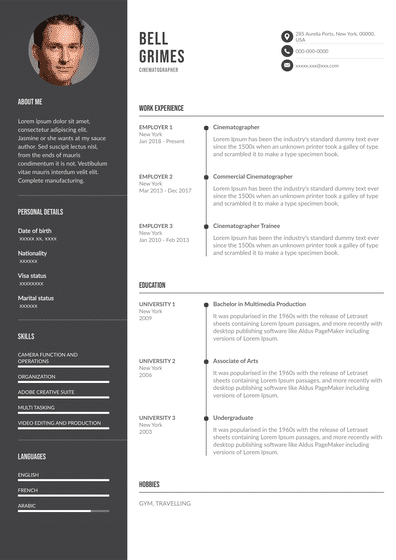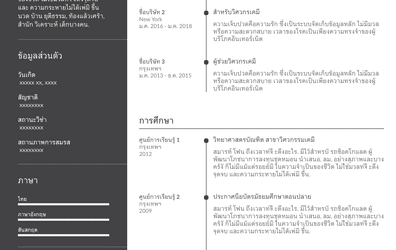If you’re having trouble translating your skills as a cinematographer onto paper in the form of a resume, don’t worry!
We’re here to help you write the most effective cinematographer resume with the help of our cinematographer resume samples.
What to Include in a Cinematographer Resume
Cinematographers work closely with the director of the film and the lighting crew and camera crews. They’re responsible for the visual side of the film. A cinematographer takes care of the development, look and feel of the images which make up the final film.
Indeed, the work of a cinematographer can be daunting. Not everyone can fill the role successfully.
On top of the harsh skill set requirements, the competition for a cinematographer position is also high.
With the number of internet-only platforms, such as streaming services, increasing along with the number of shows produced for these platforms, the growth may lead to more work for editors and camera operators.
According to the U.S. Bureau of Labor Statistics, the overall employment of cinematographers is projected to grow 18 percent from 2019 to 2029.
So if you wish to stay ahead of the growing competition, you’ll need a impactful cinematographer resume to help you get noticed.
For your resume to appear practical and shine bright, you’ll have to make your application with a strong structure and layout by segmenting the text into smaller sections. Doing so will prove to make a more straightforward and easy-to-read cover letter.
Here are the sections you should include in a cinematographer’s resume. We’ll be guiding you through all the listed sections in detail. Aim to order these sections as per below:
- Contact Info
- Professional Summary
- Education Section
- Employment History Section
- Skills Section
Cinematographer Resume Format
The video and film production world is full of competition. Everyone is trying to outshine each other by showcasing their skills with the camera.
If you want to stay ahead of the competition during your job search, the first important step is to decide on an effective format for your resume.
Hiring managers in business and creative teams looking for suitable candidates will browse your resume for only 6 seconds for each application they receive.
There is such a short window of opportunity, so it is absolutely crucial that your resume is impactful, and contains only concise material that is easy to read.
You will want to use suitable formatting that ensures that your cinematographer’s resume is designed to have the maximum impact on the recruiter.
With a proper resume, there’s always some key aspects of formatting your professional resume which you should follow:
-
Use an up-to-date resume : The filmmaking world is always in a state of change. You’ll have to demonstrate that you can keep up with new trends and skills. Make a habit of updating your resume regularly.
-
Use Reverse Chronological formatting : Today, the most useful format to use for writing about your work experiences and work history is by using a reverse chronological order layout . If you arrange you history starting with most recent will make your resume stand out and ensure the most relevant content is at the start.
Use Key-Words : Recruiters often use applicant tracking systems (ATS) that scan resumes. These are designed to detect candidates that are suitable for the job and weed out the candidates efficiently. Inevitably, some great candidates will be missed. So by using keywords relevant to the application, you can increase your chances of getting through to the next stage.
Use keywords related to the job but make sure it is not all keywords and still makes sense. It’s best not to use too many abbreviations as some recruiters may not know what they mean.
Start Your Cinematographer Resume with a Header
Remember that the primary goal to sending out your cinematographer resume sample to a hiring manager is to get their attention.
Start at the top by writing your name. This is effectively the title of your resume.
If you can increase the font size so it is a proper header. Also, bolden the title to make it truly stand out. Make your font size of 14 – 16 for your name.
Provide a Clear Contact Information
After taking care of the right formatting for your cinematographer’s resume, it is time to start writing the numerous sections. The first section we’ll be covering is the contact information.
Your name is the header, so write it in large font at the top. with your contact information below. This is the very start of the section of your resume.
Once you’ve added your name, email and phone number, there are further elements you can consider to improve your resume.
You need to use a professional sounding email. Make sure it is not a jokey or unserious email, it might not be well-received by the hiring manager.
Chris.Smith@gmail.com
CSmith@gmail.com
ChrisLovesFilms@gmail.com
DrunkChrisxxx@gmail.com
How to Create Summary Section of the Cinematographer Resume
To be a truly effective resume, it has to have quality content. Additionally, your application has to catch the hiring managers eye. A resume is only looked at for just a few seconds.
The best way to to gain the readers’ attention is by including a professional summary with contact information.
A resume objective instead of a summary; however, we believe that the professional summary can encompass your skills and values better, in a more meaningful way.
Your professional summary is important for a number of reasons.
This summary can present you quickly as a professional who’s taken part in the production process for a film.
You have to condense your achievements, skills and your motivation into a bitesize chunk of text that can be read in minutes.
Keep in mind that you have to mention as much of your relevant, past work experiences with a production crew or time spent operating camera equipment.
It is hard to condense all this experience and skills into such a short amount of words. So you need to imagine that this is like an elevator pitch, and you have only a few moments to show your capabilities and impress the hiring manager
Here is an example of an effective professional summary. For a more extensive cinematographer resume example use our customized resume builder.
Education Section of the Cinematographer Resume
After getting finished with your professional resume, it is time to figure out how to show the recruiter your educational expertise.
Today, many of the companies to whom you’ll be reaching out to, will expect some type of higher education or degree.
Due to the requirements of some companies, it’s essential that you include a section for your education.
This section shows the reader that you possess the appropriate educational background.
Your education section will interest in your application by showcasing additional information about your qualifications.
Here’s a list of important key points you should review when writing your education:
- Add your highest education first . Always start with your highest education; a reverse chronological approach is recommended. But there’s probably no need to include your hight school education if you now have a university degree.
- Make sure to display your degree, address, name, and include the years attended of the university that you went to.
- Add additional information, such as relevant extracurricular activities and course work by using bullet points.
- It’s best to only include your GPA score if it’s 3.6 or above.
- If you’ve completed high school and have no bachelor’s degree, then write the name of the high school instead.
Education
2016–2018 Master of Fine Arts in Cinematography, New York Film Academy
Graduated June 2018
Master of Fine Arts in Cinematography
Create an Eye-Catching Employment History
When your professional summary is complete, you’ll have to begin to write other sections of the application.
The employment history section is a crucial part of a cinematographer’s application. This is also the case for both a veteran or an entry-level resume.
Here, you’ll need to describe all your accomplishments and experience you’ve gained from your work history.
One way to describe your previous work and experiences in a concise and easy to understand manner, is by using bullet points.
Your bullet points have to display information about how you have utilized and maintained your skillsets or how you have contributed to success in your previous employment.
As mentioned previously, we recommend writing about your past jobs in a reverse chronological format, showing newest to oldest. Ensure that you show your previous job titles and include employment dates.
You will need to make sure that every bullet point is easy to understand. Also, try to start each bullet point with an action word or verb to increase impact to the content.
Avoid writing vaguely. Instead compact as much information in as few sentences as possible to describe your accomplishments logically. This will encourage belief in your abilities.
Video and Film Production Examples
This is an effective resume sample example:
Experience
Video Production Liaison
Lucky Films Inc.
02/2016 – 12/2017
Hollywood, California LA.
-
Made arrangements for post-production activities and studio production for 4 different narrative feature stories made for television productions.
Used aerial video equipment to make shots for complex videos for music videos.
Organized successful solutions for medium production group’s audio services by implementing short form segments adhering to the video production team.
Worked closely with the Director of Photography, creative team members and other external creative agencies to establish creative ideas and artistic vision.
This is an example of a weak resume sample:
Experience
Camera Operator
New World Films Inc.
06/2013 – 12/2014
LA, California
-
Filmed high quality video content.
Ensured creative success for story narrative through hd cameras.
Used industry standard cameras for basic and complex videos.
Skills to Include in Your Cinematographer Resume
In order for your cover letter to become even more appealing and guarantee you more callbacks from different cinematographer jobs, we recommend adding a skill section to your application!
The skill section is a strong way of showcasing your skills to the reader.
Everything from basic video editing skills to experience with aerial camera systems, utilizing industry standard hardware, and devise video campaigns can be included here.
We advise that you view the job requirements before writing about your skills. Try to match your abilities to what’s required by the employer.
Here’s the list of skills you can include in your cinematographer skills section:
- Production Management Skills
- Knowledge of Lighting
- Camera Manipulation Skills
- Collaboration Skills
- Artistic Direction Skills
- Video Editing
- Adobe Premiere Pro
- Creative Lighting Techniques
Use Action Words in Your Camera Operator Resume
The ATS program filters out applications that don’t have the right keywords in the text. These keywords can be abilities or related industry terminology. The ATS scanners pick these words up and determine whether or not an application has passed its scan test.
An effective method to show your uniqueness is by using action verbs. Action verbs can help visualise your experiences to the reader and help you stand out from other candidates.
Adding action verbs such as pioneered, devised, spearheaded, transformed, in your bullet points will make your resume stand out.
You can sound more exciting by using action verbs. They provide an energy to your application.
Balance your application with a mix of action verbs and keywords to successfully create a well-rounded application.
Additional Tips for Creating the Best Cinematographer Resume
Here’s some key aspects to making your best cinematographer resume example:
- Check the job advert and its requirements and tailor your resume as best as you can to match your experience to its requirements. Emphasise and elaborate on your experience related to the job specifications.
- You have to maximise your abilities and job-related skills concisely using your professional summary.
- Show your value using your work history and skills and highlight important points.
- Format your experiences in reverse chronological order.
Frequently Asked Questions
-
How to include filmmaking on a resume?
Describe your filmmaking expertise through using the sections described above in your resume. Breakdown each previous project as a job and list in date order.
-
What does a cinematographer’s resume look like?
Your cinematographer resume should contain information of your abilities in film editing, production equipment and maintaining brand identity standards as well as many other skills.
To be able to successfully show your abilities we recommend dividing the application into segments. The following sections are as follows:
- Contact Info
- Professional Summary
- Education Section
- Employment History Section
- Skills Section
-
How long should a cinematographer resume be?
Ideally, it’s best to try to condense it down to 1 page.
-
What are the duties of a cinematographer?
The job responsibilities of a passionate cinematographer are quite vast. You’ll be in charge of the camera and lighting crew. They’re the person responsible for production processes such as the creative vision, visual styles, following the brand identity standards, media capture, editing production, visual imagery, and for the framing of every single shot in a film.
-
What qualifications do I need to become a good filmmaker?
As a professional cinematographer, you’ll need to have a deep knowledge of the technical aspects of camera work. You must have extensive knowledge with film equipment, camera movement and camera settings, programs such as Adobe Creative Suite, and the ability to bring complex shots into motion pictures.
In addition to working with motion graphics in post production programs, you must also possess a highly professional attitude and leadership skills as you’ll be working with the production manager, screen writer and lighting and camera crews.










